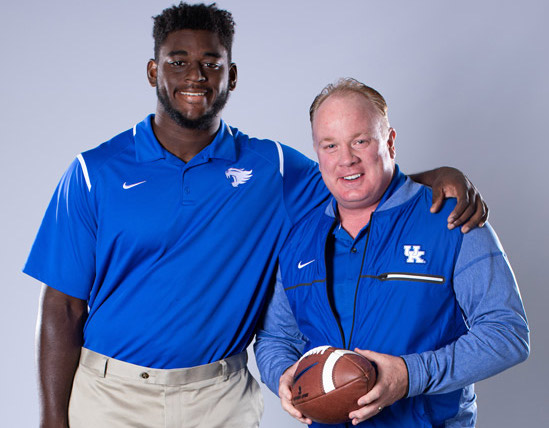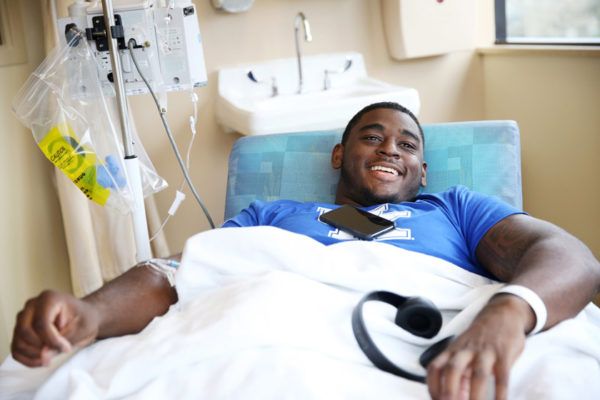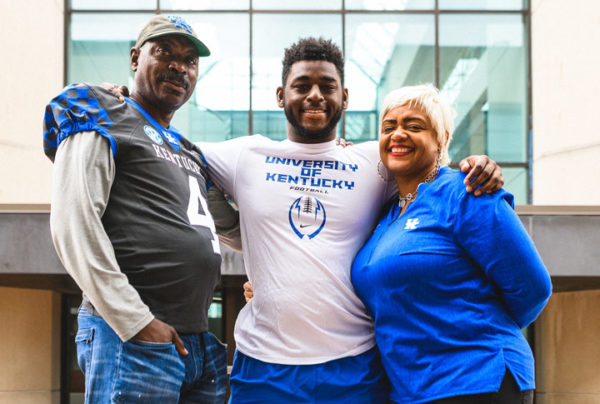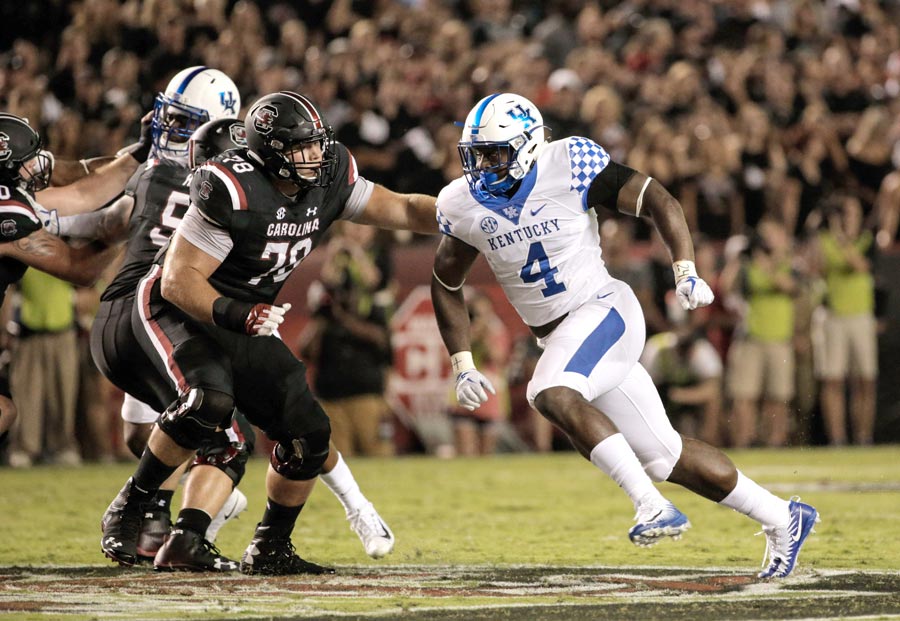Photos courtesy of University of Kentucky and UK Athletics
Josh Paschal, a University of Kentucky defensive lineman, saw something on the bottom of his foot and said something. He didn’t let his aggressive, rare type of melanoma bench him for good. With lots of support from his teams (medical and football), he tackled his grueling treatments like a warrior and fought his way back onto the playing field. Update: After Josh’s graduation, his friends, family and fans were thrilled to see him become the Detroit Lions’ 2022 second round draft pick.
By Gary Goldenberg
At 6-foot-3 and 284 pounds, Josh Paschal looks like an irresistible force and an immovable object, especially when he dons his football uniform and starts tossing opposing players around as if they were stuffed animals. And yet this monolith of a man was nearly felled at age 19 by a skin lesion with the diameter of a pencil eraser.
Josh’s dermatological journey began in the spring of 2018, during the waning days of his freshman year, when he noticed a small, dark, slightly painful patch of skin on the ball of his right foot. “When you do so much running, you think something like this is just a blood blister,” recalls Josh. Nonetheless, he showed the spot to the head athletic trainer, who told him to come back at the start of the summer session if it didn’t go away. It didn’t.
In July, the trainer took a second look. Unsure what to make of it, he sent Josh to the team’s podiatrist, who referred him to a dermatologist. The spot looked suspicious enough to warrant a biopsy.
The initial biopsy result was that Josh had an early stage melanoma, a dangerous type of skin cancer. It was clear that the lesion would have to be removed without delay.

Lean on Me: Josh, here with Coach Stoops, appreciated all the support.
Soft-spoken and even-tempered, Josh took the news in stride, shrugging off thoughts of his vulnerability the way teenagers naturally do. He expected to resume workouts in a few weeks, continuing his quest for a conference title, a national championship and, just maybe, a professional football career. Coming off a stellar freshman campaign, in which he played in all 12 regular season games, amassing an impressive number of tackles and quarterback sacks for a substitute, he had every reason to think big.
In mid-July, a surgeon removed the tumor, plus a wide swath of surrounding tissue — what doctors call a surgical margin — to help ensure that no local cancer cells were left behind. Back on campus, Josh hobbled around in a protective boot while waiting for the results, hoping he had been through the worst of it.
Blindsided!
As it turned out, though, the pathologist detected something worse: acral lentiginous melanoma (ALM), a rare, aggressive and deadly type of skin cancer that appears on the palms of the hands, the soles of the feet or under the nails, particularly in people of color. ALM comes from “acral,” an anatomical term for the peripheral parts of the body, and “lentiginous,” for freckled appearance. The five-year survival rate for Black people with melanoma is 70 percent. Put another way, Josh faced almost a one-in-three chance of dying before his 24th birthday. Most deaths from this form of melanoma occur when it is diagnosed late, after it has begun to spread.
“Many patients are in denial, or they think it’s something else and let it go for way too long,” says one of Josh’s surgeons, B. Mark Evers, MD, director of UK’s Markey Cancer Center.
That’s what happened to Bob Marley, the beloved international reggae star. When a dark spot appeared under his toenail, he attributed it to a soccer injury. It was eventually diagnosed as ALM, but he ignored doctors’ advice to have his toe amputated. Meanwhile, the cancer spread to his brain and other vital organs. He died in 1981 at the age of 36.
The news of his new diagnosis hit Josh like a blindside block. “I had been feeling invincible,” he says. “When I learned about ALM, my mind went in a thousand different directions. You never think it will happen to you, especially when you’re so young. It was a humbling moment. It made me step back from everything.”
And he would need more aggressive treatment. So in August, Josh limped to Markey Cancer Center for another operation, in which Dr. Evers cut wider and deeper around the tumor. Dr. Evers also biopsied lymph nodes in Josh’s groin, the first place that melanoma cells would appear if they had migrated beyond his foot. Josh was discharged home with a silver dollar-sized wound on his foot and a cloud hanging over his future.
 A plastic surgeon was also on hand to cover the enlarged wound with a skin flap — a partially detached patch of skin and underlying tissue that was rotated from the arch of Josh’s foot. Skin flaps can be critical for wound healing, but they’re like stealing from Peter to pay Paul. Three weeks later, the surgeons transferred a skin graft from Josh’s calf to cover the area where the flap had been excised. Dr. Evers thought that Josh’s cancer could be checked, but possibly at the cost of his gridiron career. “For an athlete, this lesion was in a terrible place,” he says. “I worried whether he would be able to play football again.”
A plastic surgeon was also on hand to cover the enlarged wound with a skin flap — a partially detached patch of skin and underlying tissue that was rotated from the arch of Josh’s foot. Skin flaps can be critical for wound healing, but they’re like stealing from Peter to pay Paul. Three weeks later, the surgeons transferred a skin graft from Josh’s calf to cover the area where the flap had been excised. Dr. Evers thought that Josh’s cancer could be checked, but possibly at the cost of his gridiron career. “For an athlete, this lesion was in a terrible place,” he says. “I worried whether he would be able to play football again.”
Now diagnosed as stage III, Josh would have to be off his foot for several months and start monthly infusions of Opdivo (nivolumab), an immunotherapy that boosts the immune system’s ability to quash cancer cells and lowers the risk of recurrence. (As luck would have it, the FDA had approved the drug for cases like his just eight months earlier.) While he was spared the worst of Opdivo’s side effects, the infusions left him fatigued and short of breath. Any hopes of playing that season were fading fast.
“It was gut wrenching,” Coach Mark Stoops said on UK Wildcats TV, after updating the sports community on the player’s condition. “It breaks my heart. He’s just a special young man.”
Recovering on the Bench
True to form, Josh became the Wildcats’ number one fan. “I was happy for my brothers,” he says. “We were having an historic season.” Whatever negative thoughts Josh had, he kept to himself. “Deep down, it was hard,” he admits. “I wanted to be out there with them and leave my mark like they did.”
Missing their teammate, the Wildcats finished every huddle with the chant “JP on three.” After their big win over the University of Florida (snapping a 31-year losing streak against the team), Coach Stoops presented game balls to Josh and assistant coach John Schlarman, who was waging his own battle with cancer.
“Appreciate all the love, support and prayers,” Josh tweeted. “God has a plan for me, and this is just a part of it. I’ll be back.”

Missing His Teammates: Immunotherapy infusions lowered the risk of recurrence but left Josh weak. Still, he never stopped believing he’d play again.
Pushed to the sidelines, Josh focused on his studies in family science and on keeping up his strength with “injury lifts” — weight-training exercises that worked everything but his right leg. All the while, he caromed around campus on a knee scooter. “It wasn’t as tiring as crutches,” he says, during an interview in his family’s suburban Maryland townhome. “The scooter was fun.”
“Yeah, too much fun,” says his dad, Clayton, rolling his eyes and laughing. “We constantly had to tell him to slow down,” adds his mom, LaTauna. Clayton, a construction worker, and LaTauna, a hairstylist, flew in from Maryland whenever possible to support Josh’s recovery.
After a few months, Josh switched to crutches. Days later, he was fully ambulatory. He continued his rehab using a water treadmill and a gravity trainer, allowing him to exercise with minimal pressure on his foot. “I had to relearn how to walk properly, heel to toe, to prevent further injury like a stress fracture,” he says. “It wasn’t painful, just awkward.”
Forward Progress
Despite his tender right foot and the ongoing infusions, Josh pushed to return to uniform — and his coaches and trainers pushed back. “There had been several games where we considered dressing him out to provide a spark of energy for the team,” says Jim Madaleno, UK’s executive associate athletics director for sports medicine. “But during workouts, he was huffing and puffing. We wanted him at the point where he was in shape and had proper proprioception [awareness of your body in space], so he could protect himself from further injury.” Josh set a more realistic goal of suiting up for an early November matchup against the University of Georgia Bulldogs, one of the Wildcats’ major rivals, only to be derailed by a blister on his right foot — this time, an actual blister. UK’s trainers subsequently devised a way to wrap his foot that protected the grafted skin.
On November 17, 2018, barely four months removed from the operating room, Josh suited up for the final home game of the season, against the Middle Tennessee State Blue Raiders. Coach Stoops honored Josh by letting him start on defense. “I want to say it was like any other game,” he says. “But it meant a lot to be on that field, to be with my team.” Late in the second quarter, he made his first tackle, energizing his teammates and electrifying the crowd. “We rewound that hit so many times,” says his mom, who had been watching from home. “He had been through so much in such a short time. It was awesome seeing him back on the field.”

We Are Family: Parents know that injuries are part of the game, but Josh’s father and mother, Clayton and LaTauna, never expected a life-threatening cancer.
Josh’s momentum carried over to the 2019 season, during which he started every regular-season game, adding considerably to his tally of tackles and quarterback sacks. Of the team’s five 2019 captains, he’s the only one slated to return for the 2020 season, so he’ll be expected to assume even more leadership responsibilities. Madaleno, for one, thinks he’s up to the task: “He educated a bunch of the adults around him with his true expression of unwavering faith, without talking about it all the time like an evangelist. You saw it in his demeanor, in his cordial communications with people. What a great example. That doesn’t come along very often.”
Indeed, it’s hard not to respect Josh, the kind of young man who takes time to pose for photos with fellow cancer patients when he’s at the hospital for his own care, and who politely peppers his responses to his elders with “sir” and “ma’am.”
Field Goals
Thanks to college football’s new “redshirt” rules, Josh’s abbreviated 2018 season does not count toward his athletic standing, leaving him with two more years of football eligibility, and two more years to impress professional scouts. “Of course, my dream is to play in the NFL,” he says. “But I just want to bring a great year to Kentucky. It’s looking good for next year. We have a lot of people coming back.”
Plan B is to go into counseling or social work, where his experience as a cancer patient and team leader would no doubt serve him well.
All through this ordeal, Josh has been more than willing to share his story with the media, not to grab his 15 minutes of fame but to spread awareness of skin cancer. He counsels everyone to do regular skin checks, echoing The Skin Cancer Foundation’s “Big See®” campaign, which advises people to look for anything new, changing or unusual on their skin (thebigsee.org). “Realize you’re not invincible,” he says. Even if you’re 6-foot-3 and 284 pounds of solid muscle.
“You never think it will happen to you, especially when you’re so young. It made me step back from everything.”
“It’s an important message,” adds Dr. Evers. “Everybody needs to understand, number one, that skin cancer is not just a disease of the elderly, and number two, it’s not just a disease of lighter-skinned individuals with a lot of sun exposure. If you see something unusual on your skin, it needs to be investigated further.”
Josh is finally done with his infusions but continues to get regular checkups and scans to make sure his melanoma hasn’t returned. So far, so good. “I’m feeling 100 percent,” he says. Great news for Josh — bad news for opposing players.
Skin of Color Stats
- Melanoma in people of color most often occurs on areas that get little sun exposure, such as the palms of the hands, soles of the feet and the nail areas.
- Black patients with melanoma have an estimated five-year survival rate of 70 percent, versus 94 percent for white patients, according to the American Cancer Society’s Cancer Facts and Figures 2020.
- Black patients are more than three times as likely to be diagnosed with melanoma at a late stage than non-Hispanic white patients. Early detection is key!
Gary Goldenberg is a freelance writer based in Westchester County, New York, where he specializes in writing for nonprofit health-care organizations.






